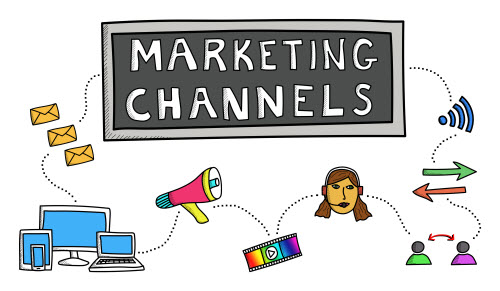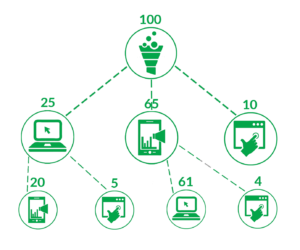I was doing some research for a client recently and I noticed that topics relating to “OmniChannel” and “Cross Media” are trending again right now.
I know its too early to talk about Christmas ☺ but I was reminded of a shopping experience I had last year which really helped me put the concept of OmniChannel and Cross Media strategy into perspective and why it is a critical component of a successful marketing campaign!
We had recently moved into a new office space and the Christmas tree that we had used in previous years just didn’t cut it any more. At the weekend, I found myself in a well known home improvement store near where I live in Dublin and I saw some Christmas trees on display. I compared the trees on offer and picked the one that looked like the best fit based on size and price. Next I took a photo on my phone and recorded the product details in evernote – I had decided to order the product online when I was back in the office and have it delivered. Simple right?

Unfortunately, the buying experience went downhill from there!
I went online and discovered that the price was higher than in the store – I contacted a sales agent using live chat who explained that there was a special offer running in store that was not available to web customers.
I found this a little annoying but decided to go ahead with the web purchase purely for convenience. Unfortunately, the delivery never arrived. I visited the website on my mobile device to call customer support but could not find a phone number – I eventually found it on their desktop site and called customer service. The agent advised that the online warehouse was out of stock for that particular product and I would need to place a new “click and collect” order and pick the item up from one of their physical stores.
Back to Square one! #marketingfail
What is the difference between Multi-Channel and Omni-Channel?
Firstly, I think the process that I followed to make the purchase is pretty commonplace in today’s hyper-connected world.
Secondly, I think it helps us understand the difference between “multi-channel” and “Omnichannel”.
Multichannel simply means that the company offers multiple channels to make the purchase. However, these channels typically operate as different divisions within the company, often with different sales goals and marketing strategies.
Omni-channel also offers multiple channels to the customer, however the main difference is that it integrates the shopping experience – The customer may start their journey using their desktop or mobile device, via phone, or in a physical brick-and-mortar store, but irrespective of the channel, the experience will be seamless. Essentially consumers can move effortlessly between “real” and “digital” worlds – I wrote a guest blog for the Customer Contact Management Association some time back on the challenge of the Omni-Channel which is still very relevant.

Secondly, this brings us to the topic of cross-media. In my earlier example, I experienced a multi-channel sales experience rather than an omnichannel one. I was presented with one marketing message in the physical store and a different message/offer on the company website. In today´s advertising world, campaigns often constitute a mix of “traditional” and “digital” media but it is important to offer a consistent message to help integrate the buying journey.
How can you measure cross-media marketing?
As we discussed earlier, in line with best practice Omni-Channel thinking, each piece of the consumer’s experience should be consistent and complementary.
One problem encountered in cross-media campaigns is that different strategies, although executed in a combination, are often measured separately, in silos.
This does not provide a complete view of a campaign and its results. It is no longer enough to have different views of the various media that impact a consumer or a buyer.
A single customer view that presents the complete customer journey is needed. A prospect or customer can embrace many touchpoints, traditional and digital, before making a purchase or closing a deal. These include watching a TV ad, listening to a radio spot, searching on the internet, attending an expo, browsing a website, visiting a store, engaging in social media, viewing a video, reading reviews, etc. All these can be part of one single customer journey, and if we don’t measure it in full, the results will provide an incomplete picture of the campaign’s performance. It also raises the issue of attribution – The TV ad may provide the initial stimulus for the consumer consideration but the Facebook ad made the consumer take action – Which campaign should get credited for the conversion?
What if they use more than one device?
In addition to cross-media, there is the aggregated complexity of cross-device. According to Pawel Gershkovich, global senior product manager at GFK, 35% of people use two devices, 22% use up to three devices when engaging in a product research or purchase.

To plan an effective campaign, marketers now need to understand what the consumer is doing across devices and how these activities interact with the traditional touch points also. Tracking all these and being able to measure the customer journey requires advanced technology, the combination of platforms, and the holistic skills of marketers that understand traditional and digital media. The data from all these media must be extracted, combined and correlated to draw useful conclusions. And despite all these, some things will not be measurable and cannot be predicted, but the more information a marketer can gather, the closer she can get to understand the consumer or buyer in her target.
Metrics need to include measuring different people, in different segments, in various campaigns, so there is an understanding of the interaction online and in the store. Increasingly, people use multiple devices during the process of a single transaction. So, marketers need to make sure that they understand these interactions and the impact they have on the customer journey.

According to a study published by Telco 2.0 Research, if we take 100 potential customers, 65 of them start their research on a Smartphone, 25 start on a PC/Laptop, and 10 start on a Tablet. But not all of them finish on the same device. For example, out of the 65 potential customers that start on a Smartphone, 61 continue on a PC/Laptop and 4 continue on a Tablet. From the 25 that start on a PC/Laptop, 20 continue on a Smartphone and 5 continue on a Tablet. And many of them might then decide to go to the physical store!
So, all these combinations present a measuring challenge that needs to be considered when the campaign is being planned.
What is the best approach for handling cross-media campaigns?
Marketers using cross-media need to start breaking the silos using technology and intelligence as a connector between the traditional silos.
The key to running integrated campaigns with multiple media elements is to ensure that each element is tagged correctly with campaign DNA.
This helps attribute the correct value to the media source providing insight into the tactics that provide the best ROI for your campaign and ensuring that you maximise your marketing budget. With advancements in technology it is now possible to connect digital campaigns to in-store purchases, whether it’s purchasing an FMCG product in a supermarket or a “walk in” to a car dealership – If done correctly, It is possible to check the marketing messages that person was exposed to during their customer journey.

We favour a funnel approach to guide your advertising spend, which shows the connection between top of funnel marketing activities like brand awareness, middle funnel activities for capturing intent like search and bottom funnel activities like remarketing. If you use a good forecasting model it is possible to forecast campaign KPIs and evaluate the impact of changing the marketing mix at the different stages of the customer funnel.
If you have a cross-media challenge that you need help with, get in touch with one of our team.
This article was inspired by my colleague Carlos Guzman. Carlos has been a member of the WSI community since 2004, he leads a digital marketing agency ranked #20 for Mexico and servicing Mexican and Latam customers. Their specialty is in social listening and analytics-based digital strategies.

Stay Connected